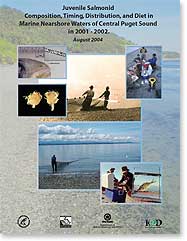Juvenile Salmonid Composition, Timing, Distribution, and Diet in Marine Nearshore Waters of Central Puget Sound in 2001-2002

King County undertook this study to provide basic life cycle information about salmonids in Puget Sound, to inform and help guide how best to reverse declines of salmonid stocks in response to the listing of Puget Sound chinook salmon as a threatened species. While the early life stages of salmonids in the marine environment are considered critical to their survival, insufficient information was previously known about how salmonids specifically use Puget Sound nearshore habitat. This report helps fill knowledge gaps to help guide development of effective policies and to apply limited resources appropriately.
The central objective of the nearshore salmonid surveys was to investigate the use of marine nearshore waters by juvenile salmonids within the study area (central Puget Sound). Sampling sites were selected throughout the study area (WRIAs 8 and 9, including Vashon/Maury Islands), within the boundaries of King and south Snohomish Counties. A 37 meter x 2 meter floating beach seine was used to collect fish, which were measured, weighed, and checked for coded wire tags and adipose fin clips (to distinguish hatchery from wild fish and origin of tagged hatchery fish). Gut contents were collected in order to determine diet composition. Relevant environmental data were also collected to characterize habitats at each sampling location. Sampling was conducted between May and October 2001, and April to December 2002.
The Juvenile Salmonid Composition, Timing, Distribution and Diet in Marine Nearshore Waters of Central Puget Sound in 2001-2002 is available in Adobe Acrobat format. For help using Acrobat files, please visit our Acrobat help page. The report is offered in multiple sections for faster download speeds and to minimize computer problems.
Download Here:
Part 1 - Cover, Table of Contents, Introduction, Methods, Results, Discussion

 Translate
Translate